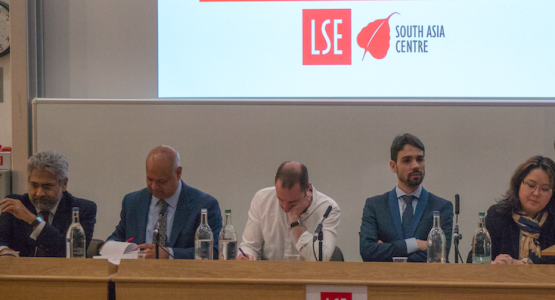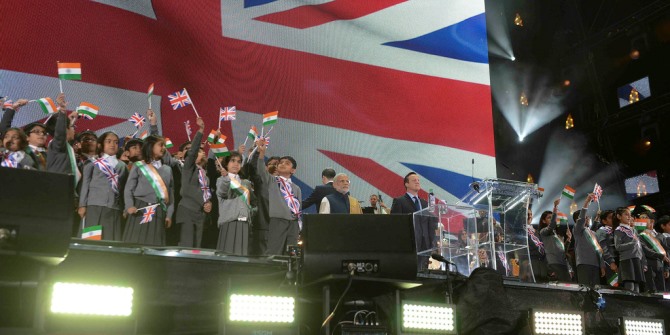 Following his participation in the opening panel of the South Asia Centre’s London summit ‘Is China South Asia’s principle ally? Rebecca Bowers spoke to Dr Filippo Boni about the challenges facing Pakistan regarding the implementation of CPEC, and the historical importance of the Sino-Pakistani relationship.
Following his participation in the opening panel of the South Asia Centre’s London summit ‘Is China South Asia’s principle ally? Rebecca Bowers spoke to Dr Filippo Boni about the challenges facing Pakistan regarding the implementation of CPEC, and the historical importance of the Sino-Pakistani relationship.
In light of China’s current investment in Pakistan, but also with India’s involvement in the Quad initiative as well, what would you say are the ramifications of both of these alliances for the Pakistan-India relationship?
As I also mentioned during my presentation, CPEC has added an additional element of complication into what was already quite a tense relationship between Pakistan and India. These tensions are not going away any time soon.
With regards to China’s approach towards India, this has slightly changed. We’ve seen recently that China has come to realise that it cannot disregard and rule out India in its regional considerations. China-India trade was around 84.4 billion in 2017, so the magnitude of trade also tells us something about the importance of Sino-India ties.
It will be interesting to see in the long run how these dynamics evolve. There seems to be a growing consensus with segments of the Pakistani society that India needs to be taken on board in order to make the most out of CPEC. On its side, China has opened a door to rename the China-Pakistan Economic Corridor in order to assuage New Delhi’s concerns. How far will this initiative go? Will the Pakistani military raise any objections in this respect?
Will China and India be able to manage their competing interest in the region? These are all important questions that will be interesting to follow in the near future.
So I wanted to talk a bit more about the historic context of China and Pakistan’s relationship which has been described as an ‘All-weather friendship’, can you provide some context to this?
I am glad you brought this up as it is an important time to reflect on what the history of Sino-Pakistani ties can tell us about the current state of the relationship.
It is possible to identify five different phases in the evolution of Sino-Pakistani relations. The first begins with the establishment of diplomatic relations between the two countries in 1951, to 1963, when Pakistan and China signed a border agreement over Kashmir. The second phase is from 1964 to 1971 and this is the period in which the relationship really develops in terms of trade relations as well as political support during the 1965 Indo-Pakistani war. In this period, the driving factor behind Pakistan-China relations was the anti-Indian orientation of both countries. The third phase spans from 1971 to 1977 and we see the development of Pakistan’s nuclear programme with extensive and substantial Chinese support. The fourth phase covers the period comprised between 1978 to 2000 and is characterised by the Soviet invasion of Afghanistan, by the nuclear tests conducted by both India and Pakistan and by the Kargil conflict in 1999. Finally, from 2001 to 2016 we have seen a significant increase in trade and energy cooperation between Pakistan and China.
Looking at the history of Sino-Pakistani relations, one of the recurring themes when assessing the partnership between Islamabad and Beijing is the support (or lack thereof) provided by China during Pakistan’s foreign policy crises, especially during the 1971 war leading to the independence of Bangladesh and the Kargil conflict in 1999. This is something that is also very important to understand the present day context in light of the Financial Action Task Force (FATF) decision to put Pakistan on the grey list for terrorist financing in June 2018. What do these events tell us about Sino-Pakistani relations?
The major lesson that can be drawn is that China is willing to consistently support Pakistan up to a certain extent. It’s indeed a strong partner of Pakistan and whilst the US has been zooming in and out from South Asia at different points in time, China has always been present, so it’s consistency which matters in this case, not much the intensity because China has demonstrated in a few different instances that it doesn’t really want to go beyond a certain threshold. This is particularly true for the crisis provoked by Pakistan itself.

The panel session of ‘Is China South Asia’s Principle Ally?’ at the South Asia Summit, March. (L-R) Siddarth Varadarajan, Dr Rahul Roy-Chowdhury, Dr Luke Heslop, Dr Filippo Boni and Dr Yuka Kobayashi. Photo credit: Evelina Hepp, E H Photography.
With this in mind, there has been some scepticism regarding the extent to which CPEC is going to bring economic growth to the region. You were saying that quite a lot of the population in Pakistan are optimistic, maybe the business community is perhaps more cautious, but what would you say are the main concerns from Pakistan’s point of view towards these projects?
According to Gallup opinion polls in February 2017, 85% of the respondents considered CPEC as important (‘very important’ and ‘somewhat important’) for Pakistan’s development. Along the same lines, a poll published in February 2018 by the Pakistan-China Institute reports that 49.6% of the respondents ‘strongly agreed’ that CPEC will have a positive impact on Pakistan’s economy. While there seems to be a general of consensus that CPEC provides opportunities for Pakistan, concerns revolve primarily around four points.
The first one is the employment opportunities for the local population – are the Chinese bringing in their own force? There is some interesting data which comes from both the planning commission and the Chinese embassy which gives us an idea that local force is being included on a number of projects (30,000 engineers and workers in total according to this data). Yet concerns are still being raised in relation to long-term opportunities.
Directly related to the previous one, the second element of concern is the extent to which CPEC will benefit the whole of Pakistan. There is the need to bring the provinces on board in order to make it a success story – that’s something we didn’t really see in the first phase, it’s something which is coming with some difficulties. The debate about the CPEC route and the neglect of the smaller provinces has very much characterised the first two years since CPEC was officially launched in 2015, although some signs of greater provincial inclusion seem to emerge at the level of the Joint Cooperation Committee. It is therefore very important to understand CPEC not only through a geopolitical and economic prism, but also through the lens of federalism and whether CPEC is altering the existing equilibria.
The third element of concern is the trade imbalance between the two countries favouring China. This a trend that we can observe since the 1970s and that is likely to be accentuated in these first years of CPEC development as Pakistan is importing machinery from China. Pakistan and China signed a Free Trade Agreement in 2006, which entered in operation in 2007 and are now in the process of negotiating a second phase, not without difficulties. According to news reports, during the 10th round of negotiations in April 2018 the two sides did not reach an agreement on the terms of the new FTA because of the trade deficit that Pakistan was facing with China.
Finally, the fourth aspect that should be carefully considered is the debt sustainability of the projects coming under CPEC. This is not only a concern specific to Pakistan but that also applies to most countries along the Belt and Road Initiative. For instance, the Hambantota Port in Sri Lanka might serve as a powerful reminder of the implications of excessive debt exposure to China.
You mentioned China’s role in the PML N’s hopes for re-election. How significant a role is this in terms of the political landscape in the next few years and the elections?
This is a very good question. China has been much more involved into the day to day Pakistani politics than it has been in previous years. For instance, when Nawaz Sharif was disqualified by the Supreme Court in July last year and the new cabinet was sworn in, Ahsan Iqbal, the Minister for Planning and Development was moved to the Ministry of Interior. The Chinese were concerned about it since he acted as an important reference point for CPEC with the Chinese side. There were reports in the Express Tribune, one of the Pakistani newspapers, mentioning that the Chinese wanted him back to the planning commission, which happened shortly after. Looking ahead, we are likely to see China’s engagement to remain constant and I don’t see how, from the Pakistani side, the relationship would change with another party in government.
With a PML-N government and Shahbaz Sharif Prime Minister we will see more of the same, perhaps even a deepening of the relationship. Likewise, both the PTI of Imran Khan and the PPP have expressed their full support towards CPEC and will likely try to make the most out of it if they get the chance to govern, although this is very uncertain at the moment.
Overall, there is very much the consensus that CPEC is a huge opportunity for the country and everyone wants to have a piece of the cake. And obviously no one wants the damage of being the party that presides over its failure. No one wants to see it derailed. China has made CPEC the flagship project of the BRI so that it sends a signal to the world: if we make it here, we can make it everywhere so there is very much a political determination to make it a success story.
Absolutely.
This interview has been edited for clarity. It gives the views of the author, and not the position of the South Asia @ LSE blog, nor of the London School of Economics. Please read our comments policy before posting.
Cover image: Chinese trucks waiting at the Pakistani customs border, Karakoram Highway. Photo credit: Anthony Maw, CC BY-SA 3.0.
About the Authors
 Dr Filippo Boni is a Teaching Fellow at the Department of Political Science and International Studies, University of Birmingham. He completed his Ph.D. from the University of Nottingham on ‘Civil-military relations in Pakistan: an analysis of Sino-Pakistani ties 2001-2016’. Filippo is currently working on his first book on Sino-Pakistani relations since 2001 and he is part of the ‘Observatory on South Asia’ a project sponsored by the French Ministry of Defence in collaboration with the NORIA South Asia Programme. He tweets @FilippoBoni1
Dr Filippo Boni is a Teaching Fellow at the Department of Political Science and International Studies, University of Birmingham. He completed his Ph.D. from the University of Nottingham on ‘Civil-military relations in Pakistan: an analysis of Sino-Pakistani ties 2001-2016’. Filippo is currently working on his first book on Sino-Pakistani relations since 2001 and he is part of the ‘Observatory on South Asia’ a project sponsored by the French Ministry of Defence in collaboration with the NORIA South Asia Programme. He tweets @FilippoBoni1
 Rebecca Bowers is a blog editor at the South Asia Centre and a final year PhD student in the Anthropology Department at the London School of Economics. Rebecca’s research explores the lives of female construction workers and their families in Bengaluru, India.
Rebecca Bowers is a blog editor at the South Asia Centre and a final year PhD student in the Anthropology Department at the London School of Economics. Rebecca’s research explores the lives of female construction workers and their families in Bengaluru, India.







